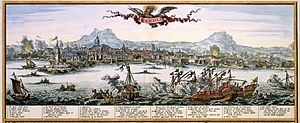Siege of Candia facts for kids
Quick facts for kids Siege of Candia |
|||||||||
|---|---|---|---|---|---|---|---|---|---|
| Part of the Cretan War (Fifth Ottoman–Venetian War) | |||||||||
 The siege of Candia by N. Visscher, c. 1680 |
|||||||||
|
|||||||||
| Belligerents | |||||||||
| Ottoman Tunis | |||||||||
| Commanders and leaders | |||||||||
| Köprülü Fazıl Ahmed | Francesco Morosini | ||||||||
| Strength | |||||||||
|
|
||||||||
| Casualties and losses | |||||||||
| 118,754 soldiers (Venetian reports) | 30,985 Venetian soldiers (Venetian reports) | ||||||||
The Siege of Candia was a very long military battle. It happened in the city of Candia, which is now called Heraklion on the island of Crete. The Ottoman army surrounded and attacked the city. Candia was then ruled by the Venetians.
This siege lasted for 21 years, from 1648 to 1669. It is one of the longest sieges in history. The Ottomans won the battle. However, the huge effort and cost of the siege also weakened the Ottoman Empire. This happened especially after the Great Turkish War.
Contents
Why the Siege Started
In the 1600s, the power of Venice in the Mediterranean was getting weaker. At the same time, the Ottoman Empire was growing stronger. The Republic of Venice believed that the Ottomans were looking for any reason to start more wars.
A Ship Attack Leads to War
In 1644, a group called the Knights of Malta attacked an Ottoman convoy. This was a group of ships traveling from Constantinople to Alexandria. The Knights took many valuable things from the ships. They also captured important people, like a chief from the Harem and a judge from Cairo. These people were on their way to Mecca for a religious journey.
The Knights landed at Candia with all their loot. This made the Ottomans very angry.
Ottomans Invade Crete
In response, 60,000 Ottoman soldiers, led by Yusuf Pasha, landed on Venetian Crete. Many people thought they were going to attack Malta. But the Ottomans surprised everyone by attacking Crete in June 1645.
They surrounded and took over two cities: La Canea (now Chania) and Rettimo (now Rethimno). Each of these cities took two months to conquer. Between 1645 and 1648, the Ottomans took control of most of the island. Then, they got ready to attack Candia, the capital city.
The Long Siege of Candia
The main attack on Candia started in May 1648. The Ottomans spent three months surrounding the city. They cut off its water supply. They also stopped Venice from sending supplies by sea. The Ottomans kept attacking the city for the next 16 years, but it was hard to break through.
The Venetians tried to stop the Ottomans from getting supplies. They tried to block the Dardanelles, a narrow sea passage. This led to many sea battles.
The Venetians won two important battles in 1655 and 1656. However, their commander, Lorenzo Marcello, was killed in the second battle. In 1657, the Ottoman navy won a big victory against the Venetians. The Venetian captain, Lazzaro Mocenigo, was killed when a ship mast fell on him.
More Help Arrives
After 1659, Venice started getting more help from other European countries. This happened after the Treaty of the Pyrenees brought peace between France and Spain. However, a peace treaty in 1664, called the Peace of Vasvár, freed up more Ottoman soldiers. These soldiers then joined the fight against the Venetians in Candia.
Turning Points in the Siege
In 1666, the Venetians tried to take back La Canea, but they failed. The next year, a Venetian military engineer named Andrea Barozzi switched sides. He told the Ottomans about weak spots in Candia's defenses.
On July 24, 1669, a French force tried to help Candia. They attacked by land and sea. But their mission failed. They even lost a large warship, La Thérèse, to an accidental explosion. This double disaster greatly lowered the spirits of the city's defenders.
After the French left in August 1669, the Venetian commander, Francesco Morosini, was left with only 3,600 healthy men. They also had very few supplies. So, he decided to surrender to Ahmed Köprülü, the Grand Vizier of the Ottoman Empire. This happened on September 27, 1669.
Morosini surrendered without getting permission from the Venetian Senate. Because of this, he was a controversial figure in Venice for some years.
After the Surrender
As part of the surrender agreement, all Christians were allowed to leave Candia. They could take whatever they could carry. Venice was allowed to keep three fortified islands: Gramvousa, Souda, and Spinalonga. These islands had good harbors where Venetian ships could stop.
Even though they lost Candia, the Venetians gained some land in Dalmatia. This helped to balance out their defeat.
Other People Who Participated
Many people from different places helped in the Siege of Candia:
- The Knights of Malta fought in 1668.
- François de Beaufort, a French leader, died there.
- Philippe de Montaut-Bénac, a marshal under the duke of Beaufort.
- Philippe de Vendôme, the nephew of the duke of Beaufort.
- Vincenzo Rospigliosi, an admiral and nephew of Pope Clement.
- Georg Rimpler, a German engineer.
- Charles de Sévigné
- Louis de Buade de Frontenac
See also
- Naval battles of the Cretan Wars
- History of the Republic of Venice
- Ottoman Navy
- Ottoman wars in Europe



